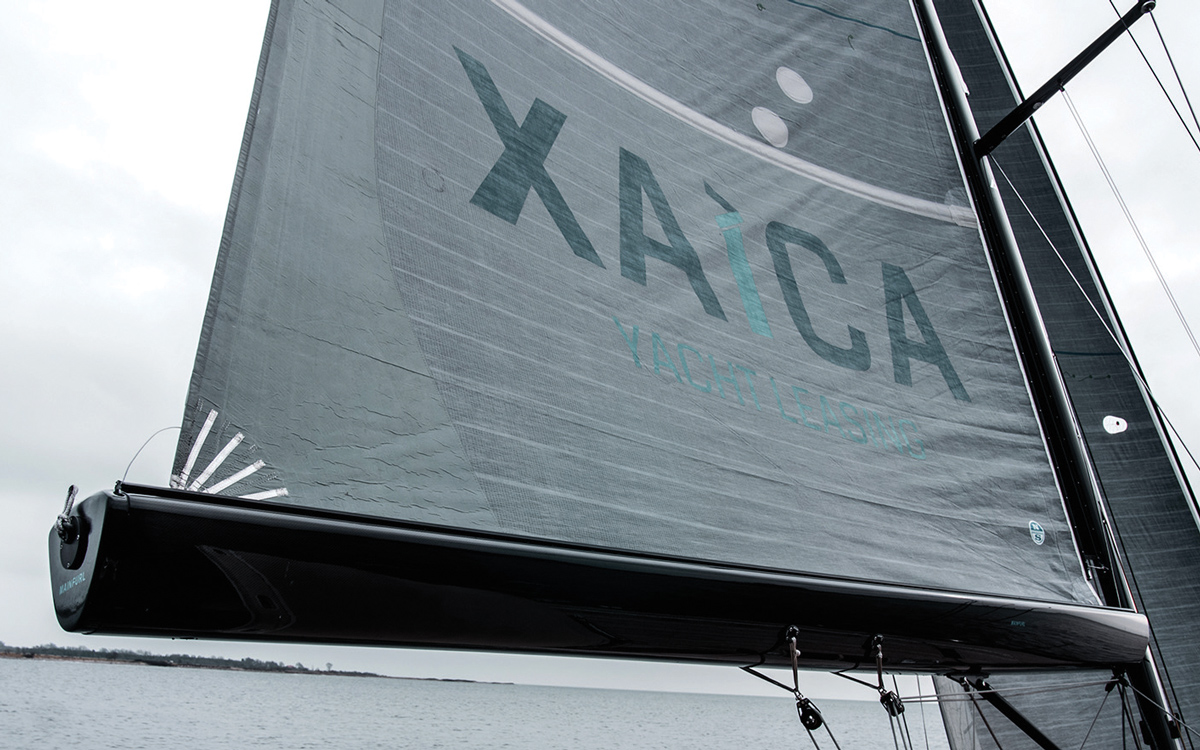What’s on the market? 9 options for in-boom furling
Mainfurl
This newly launched system has a V-shape carbon boom and is available in five sizes for boats of 40-70ft. The Danish company, whose team has 50 years of experience with in-boom systems, says it paid attention to every detail to make the system “both elegant and practical.”
The prototype was tested on an Xc45 using the boat’s electric coachroof winches. When hoisting, one turn of the furling line can be held around a winch to give the necessary resistance and the same can be done with the halyard when lowering the sail.
Following the trial, sales and marketing director Peter Westfal told Yachting World: “We are very happy with the result [and] all features were working like we expected.”

Mainfurl system sits within a V-shaped carbon boom
An electric motor can be built into the mandrel to provide a more automated solution, with the endless manual furling line retained as a backup.
A Dyneema strop of exactly the right length is provided to hold the boom against the gas vang at the correct height. The gooseneck fittings and luff track are designed for easy retrofitting to existing carbon and aluminium masts.
Neat features include grooves for attaching both sail cover and cockpit awnings. The mandrel is raised at the outboard end of the boom, which gives a more appealing aesthetic, as the aft end of the boom doesn’t appear to be raised as high.
On the downside, Westfal tells me the system can’t be used to furl when sailing downwind, but that it is possible on a reach if mainsheet and vang are eased to take the pressure out of the sail. Price: £33,600 for a 45ft yacht.

A Grand Soleil 45 sailing in Rhode Island with a Schaefer in-boom furling system
Schaefer Marine
Massachusetts-based Schaefer Marine engineers its systems using machined aluminium components, which are sleeker and lighter than castings, but more expensive. A key benefit of this system, which was originally developed in 2001, is that reefing can take place on any point of sail, including with the wind aft. This is achieved with a ‘scoop’ that leads the luff tape into a patented articulating mast track that maintains alignment with the gooseneck.
The furling drum is mounted at the aft end of the boom to free up space for a neat arrangement at the gooseneck. The downside is this furler position adds a little friction, but that’s unlikely to be a problem on a boat with electric winches. To minimise friction elsewhere, oversized dual race Torlon bearings are used at each end of the mandrel.
A heavy duty fixed rigid vang ensures the boom is always at the correct angle for consistently reliable operation at the expense of losing control of mainsail twist.
The system is available in two versions, Beta and Gamma, to suit maximum luff lengths of 13.4m (44ft) and 16.4m (54ft). The UK distributor is Warsash-based Sea Sure. Prices ex VAT: Beta US$13,800 (approx £11,000); Gamma US$19,900 (approx £16,000).
Leisure Furl
This well established brand is part of California-based Forespar and has produced thousands of systems for boats from 9-24m (24-79ft), plus custom units for yachts up to 100ft.
The company says furling can be carried out when sailing downwind, with the boom sheeted in to 45° to move the sail away from shrouds and spreaders. The furling drum is on the front of the mast and incorporates a manual override option.
Leisure Furl produces eight models for boats from 27-70ft in aluminium or carbon. Average price ex VAT for a 45-footer: US$16,000 (approx £13,000).
Romar Leisure Furl
This Dutch company was a Leisure Furl distributor, but now offers its own product in carbon or aluminium construction, with most being aluminium for yachts in the 45-80ft bracket. These are fabricated from shaped aluminium plates, bonded with epoxy resins using techniques developed in the automotive and aerospace sectors.
“This switch was done to get rid of any corrosion and to create a stiffer boom,” says CEO Johan Mulder. It also reduces costs by around 50% compared to a carbon boom, although a carbon fibre mandrel is used for extra stiffness. Manual, electric or hydraulic operation is available. Prices start from €18,000 for a 45ft yacht.
Furlerboom
This is a 20-year-old Danish company whose products have been fitted to a wide range of yachts, from production cruisers to top quality designs.
Booms are produced in fibreglass, carbon and composite with a carbon appearance, for yachts from 36-70ft. They incorporate cockpit lights – white for use in port and red for night sailing – on the underside of the boom. Guide prices ex VAT for a 45ft yacht: fibreglass €27,432; carbon €41,208.
John Mast
Danish spar manufacturer John Mast which produces the Hi-Low reefer system in three models to suit boats from approximately 6-12m (20-40ft). This costs €8,292 for a 40ft yacht.
Profurl
Part of the French Wichard Group, Profurl has a wide range of in-boom systems for boats from 5-18m (17-59ft) with aluminium spars.
Sailtainer
Sailtainer is a long-standing brand, with more than 1,000 units produced, and is sold in the UK by Jeckells. The furling drum is at the aft end of the boom and the system is available in sizes to suit luff lengths from 5-24m (16-79ft).
Hall Spars
Hall Spars, part of the North Technology Group, produces five all-carbon models, catering for yachts from 40-100ft. The system’s geometry allows the mainsail to be furled or reefed while sailing downwind. Manual, hydraulic and electric drives are available.
First published in the July 2020 edition of Yachting World.





